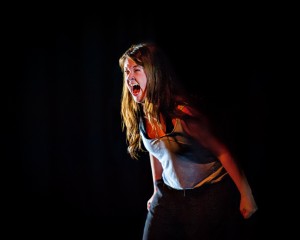I must admit that this is a difficult play to review, and I found myself the following day still mulling over what everything actually meant in terms of themes and central message. In effect, what was actually being said here. I came to the conclusion that sometimes theatre rebels against traditional concepts of simply conveying a story and characterization, even though I am still a little baffled in my attempts at interpretation.
Barrel Organ is a politically engaged theatre formed in the West Midlands, and its innovative nature was evident in ‘Some People Talk about Violence.’ If its main aim was to disturb and incite curiosity, it proved successful. However, sometimes it is difficult to define what the audience takes away from the production when it is too obscure, and I believe it is possible to make the audience think as well as to establish a subtle manner.
At the beginning we were given a leaflet that stated that the performers did not know which part they would play or which sections of the show they would perform. This was not altogether convincing as there were two females and two males, and the parts were conveniently assigned to the correct sex.
The cast consisted of Joe Boylan, Bryony Davies, Craig Hamilton and Ellice Stevens.
I began to sink my teeth into the story, but it rapidly became to feel like a series of disconnected performances rather than a tightly-knit play. The main issue for me was the apparent lack of driving force that guided us through the scenes. As standalone units, they entertained and provided food for thought. As a play, the elements did not link together in a unified piece in my opinion. I was also unsure how much of the dialogue was scripted or improvised, and the director Ali Pidsley could possibly have ensured that the play has a clear and thought-out focus throughout.

Nevertheless, certain elements were memorable. Instances where the characters played with words and interrupted each other made me think of our fast-paced busy world and how it is difficult to get your voice heard or be understood. The significance of ‘I love you, I miss you’ was also powerful as meaningful words that are sometimes used lightly, even though I was unsure of the significance of the cream crackers. I interpreted it as the inability of people to care or understand when we try to voice what we mean, especially as globalisation impacts society to the extent that people do not listen. A girl screaming mutely as others danced was especially gripping as it possibly suggested how we don’t reach out to people who have something to share in our community.
The monologues were particularly funny and powerful, especially that of the girl, even though the colourful language and sexual references is not for the faint-hearted! The relationship between the actors indicated that they responded well to each other. I was not convinced by the concept of audience participation, as I didn’t feel it reinforced any of the intended messages or served a particular purpose. The symbol of red paint was evident, but such aspects could have been accentuated further in order to explicitly express their relevance for the audience. I particularly liked the scene when two actors had to guess the details of a scenario outlined by the narrator, which served well to open our imagination. It also made me consider that the world is full of stories and revelations that we do not know, and this tenet could have been examined further.
I must commend the inventive and experimental approach to theatre seen here, but sometimes enhanced creativity can cause the audience to miss the point. Globalisation and violence are extremely prevalent in our world today, and exploring them in more depth and narrative may have enhanced their impact on the audience. However, it contained a high degree of strong components that could be built upon to create a more nuanced play.
If you like to be challenged and you strive for alternative theatre that moves away from more traditional parameters, this is the production for you. There are thought-provoking elements here, but the central message could have been much more defined in order to provide the audience with a well-rounded and satisfying experience.